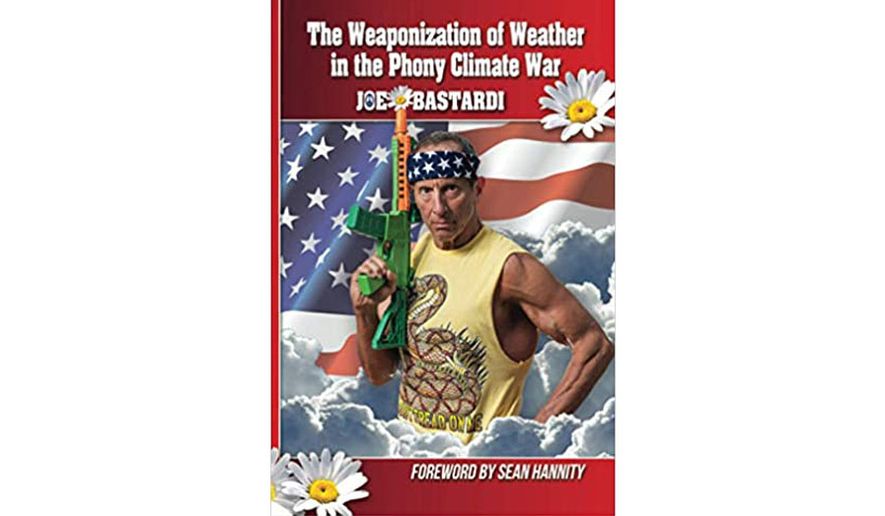https://www.washingtontimes.com/news/2020/sep/22/book-review-the-weaponization-of-weather-in-the-ph/
ANALYSIS/OPINION:
The Energy Policy Institute at the University of Chicago reported in January 2019 that “[f]orty-eight percent of Americans find the science on climate change to be more persuasive than it was five years ago, with three-quarters of them crediting recent extreme weather events for changing their views” This conclusion was based on results from a November 2018 survey of Americans age 18 and older conducted by the Energy Policy Institute and The Associated Press-NORC Center for Public Affairs Research.
Climate change concerns could be reasonably mitigated if more people would carefully consider The Weaponization of Weather in the Phony Climate War by Joe Bastardi. As Mr. Bastardi says, this book “examines and compares past events with the hope that a rational person will at least take a look.” In addition, The Weaponization of Weather addresses front-page issues such as the connection of COVID-19 to climate change and touches on the influence of ideology and politics to the conduct of science.
In “The Weaponization of Weather,” Mr. Bastardi proffers one of the best challenges to the hysterical claims that humans are causing over-the-top climate change by demonstrating that “extreme weather” can be predicted based on its natural occurrence in history. Mr. Bastardi is a weather historian with an encyclopedic knowledge of past weather events. He is a long-time practitioner in the atmospheric science field with 45 years of experience. And, Mr. Bastardi is a frequent guest on the Sean Hannity Show, where he predicts and explains current extreme weather conditions such as imminent hurricanes and snowstorms. (By the way, Sean Hannity wrote the foreword to Mr. Bastardi’s book.)
In chapter after chapter, Mr. Bastardi shows how extreme weather and its consequent impacts on the environment is really just weather doing what weather does. As in his previous book, The Climate Chronicles: Inconvenient Revelations You Won’t Hear from Al Gore—And Others, Joe explains how understanding extreme weather events from the distant past (i.e., historic analogs) leads to accurate contemporary forecasts.
And, if such extreme events can be predicted from their previous occurrence, doesn’t that call into question the claim that these events are somehow unusual and now based on human activity? Link the understanding of past conditions with the cyclical nature of climate and you have the key ingredients for a reliable forecast.
And Mr. Bastardi’s forecasts have to be reliable. His living depends on him being right, day after day, week after week. He is not in the fortunate business of prognosticating decades ahead, when validating a forecast is well beyond your last career paycheck.
Mr. Bastardi notes: “As someone who relies on the past to frame the future, no stretch of U.S. weather was as extreme as the 1930s to 1960s. Honestly, everything from hurricanes to droughts to extreme heat to extreme cold during that period make the past several decades seem rather boring. But you’d only be able to acknowledge this if you know your weather history. For some people to pretend as if today’s events are a sign that man is responsible for ‘weird’ weather certainly has me questioning their methods.”
Even just a few decades ago, before political science overshadowed atmospheric science, at a time when disco was animating the dance floor, it was reported by one popular book—Our Changing Weather: Forecast of Disaster? by Claude Rose (Kensington Pub. Corp., 1977)—that “[s]cientists no longer debate the coming of a new ice age: the question now is when?” Joe and I were acclimated to this concern even in meteorology classes at Penn State University in the mid-70s. Yet today, replace “new ice age” in the above quote with “dangerous global warming,” “global weirding,” or “climate disaster” and you’d be the disco diva of the 20s.
Indeed, it seems that a formula can be identified for reporting every notable weather event and its impact as evidence for manmade climate catastrophe. That formula appears to be: identify a serious weather event; figure out what is unique about that event; claim the uniqueness is because of human activity; then, get the media, celebrities, talking heads, and the like to propagate the puffery. “The Weaponization of Weather” effectively challenges that apparent approach and at a time when the public must become more well-versed in science and how science is supposed to work.
Mr. Bastardi’s accessible, colloquial style—delivered with plenty of passion for atmospheric science and its proper understanding without the hype—makes The Weaponization of Weather a delight for readers to gain a greater appreciation for the complexity and majesty of the climate.
• Anthony J. Sadar is a Certified Consulting Meteorologist and author of In Global Warming We Trust: Too Big to Fail (Stairway Press, 2016).



